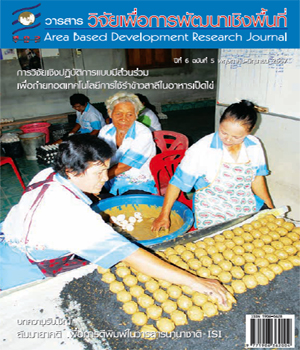การจัดการห่วงโซ่อุปทานผักอินทรีย์แบบบูรณาการ กรณีศึกษา : โรงพยาบาลเชียงรายประชานุเคราะห์
Main Article Content
Abstract
การวิจัยครั้งนี้มีวัตถุประสงค์เพื่อศึกษารูปแบบการจัดการโซ่อุปทานผักอินทรีย์แบบบูรณาการของโรงพยาบาลเชียงรายประชานุเคราะห์ ตลอดจนวิเคราะห์ปัญหาและอุปสรรคของการจัดการโซ่อุปทานผักอินทรีย์ที่เกิดขึ้น เป็นงานวิจัยเชิงคุณภาพ ที่ใช้วิธีวิทยาวิจัยของทฤษฎีฐานราก (Grounded Theory) หรือการสร้างทฤษฎีจากข้อมูลประชากรกลุ่มตัวอย่าง ประกอบด้วยนักโภชนาการชำนาญการ สำนักบริหารการสาธารณสุข กระทรวงสาธารณสุข หัวหน้าฝ่ายโภชนาการ โรงพยาบาลเชียงรายประชานุเคราะห์ เกษตรกรกลุ่มหลักที่ส่งผักเข้าครัวของโรงพยาบาลทั้งเกษตรกรรายเดี่ยวกลุ่มเกษตรกรและผู้รวบรวม เกษตรตำบล ผู้ค้าที่ตลาดนัดภายในโรงพยาบาล ผู้ค้าตลาดสดเทศบาลและเจ้าหน้าที่ของโครงการหลวงสะโง๊ะ จำนวนกลุ่มตัวอย่างรวมทั้งสิ้น 12 คน พื้นที่ในการวิจัย คือฝ่ายโภชนาการโรงพยาบาลเชียงรายประชานุเคราะห์พื้นที่เพาะปลูก ตลาดนัดภายในโรงพยาบาล ตลาดสดเทศบาล ในเขตอำเภอเมือง จังหวัดเชียงราย และโครงการหลวงสะโง๊ะ อำเภอเชียงแสน จังหวัดเชียงราย เครื่องมือที่ใช้ในการเก็บรวบรวมข้อมูล คือ การสัมภาษณ์เชิงลึก การสนทนากลุ่มและการสังเกตแบบมีส่วนร่วม โดยใช้แบบสัมภาษณ์แบบกึ่งโครงสร้างปลายเปิด แบบฟอร์มการเก็บข้อมูลทางการเงิน เป็นต้น การวิเคราะห์ข้อมูลในรูปแบบการวิจัยของทฤษฎีฐานราก นั่นคือการวิเคราะห์ข้อมูลในระหว่างการเก็บข้อมูลย้อนกลับไปกลับมาหลายๆครั้ง จนข้อมูลสามารถนำไปจัดหมวดหมู่เพื่อการสรุปเป็นข้อค้นพบจากการวิจัยได้ ผลการวิจัยพบว่า (ก) การจัดการโซ่อุปทานของระบบเกษตรอินทรีย์เข้าสู่ครัวโรงพยาบาลเป็นลักษณะที่บูรณาการระหว่างฝ่ายโภชนาการของโรงพยาบาล (Demand Side) และฝ่ายเกษตรกรหรือผู้รวบรวม (Supply Side) โดยทางโรงพยาบาลมีการวางแผนล่วงหน้าที่สามารถระบุวัตถุดิบ (ผักอินทรีย์) ที่ต้องการใช้ในช่วงเวลาที่แน่นอน เพื่อประสานไปสู่ฝ่ายผู้รวบรวมหรือเกษตรกรหรือกลุ่มผู้ผลิตผักอินทรีย์ ในการเตรียมวัตถุดิบให้พร้อมจัดส่งในแต่ละช่วงเวลาที่กำหนด (ข) ปัญหาที่เกิดขึ้นในส่วนต้นน้ำ คือ เกษตรกรปลูกผักได้ปริมาณไม่เพียงพอกับความต้องการ โดยเกษตรกรควรแก้ปัญหาโดยการรวมกลุ่มและสร้างเครือข่ายผู้ปลูกผักให้มากขึ้น ส่วนทางโรงพยาบาลต้องหาเครือข่ายผู้ปลูกผักเพิ่มเติม ปัญหาในส่วนกลางน้ำหรือผู้รวบรวมคือการขาดแคลนเงินทุนที่ใช้รับซื้อผักจากเกษตรกร เนื่องจากต้องรอเวลาในการเบิกจ่ายของโรงพยาบาลเนื่องจากเป็นระเบียบของส่วนราชการ ซึ่งโรงพยาบาลควรตั้งวงเงินสดย่อยสำหรับเกษตรกรโดยเฉพาะ ปัญหาในส่วนปลายน้ำคือผลผลิตไม่เพียงพอและไม่ตรงตามความต้องการของฝ่ายโภชนาการ ต้องมีการแลกเปลี่ยนข้อมูลระหว่างฝ่ายโภชนาการและเกษตรกรอย่างสม่ำเสมอ (ค) ปัจจัยแห่งความสำเร็จของการจัดการโซ่อุปทานเกษตรอินทรีย์ อยู่ที่การสร้างเครือข่าย โดยดำเนินงานในเชิงรุก ทำงานร่วมกับชุมชนและเครือข่าย เป็นการบูรณาการโซ่อุปทานผักอินทรีย์ทั้งในโรงพยาบาลและภายนอกโรงพยาบาล มีการวางแผนและแลกเปลี่ยนข้อมูลร่วมกันทุกขั้นตอนตั้งแต่ต้นน้ำ กลางน้ำและปลายน้ำ
Integrated Supply Chain of Organic Vegetables : Case Study of Chiang Rai Prachanukroh Hospital
The purpose of the research was to study patterns, problems and obstructions of the Integrated Supply Chain of Organic Vegetable: Case Study of Chiangrai Prachanukroh Hospital by means of grounded theory, ie the discovery of theory through the analysis of data. The sampling of this research consisted of Nutritionist, Professional Level at Bureau of Health Administration Ministry of Public Health, Nutrition Department of the hospital, Single farmers and farmers groups, collectors, Agricultural Extension Officer, Greengroce at market fair in the hospital and Greengrocer at fresh-food market, Royal Project Sahngo. The sample consisted of 12 Individuals. The areas covered in this research were the Nutrition department of Chiangrai Prachanukroh Hospital, farm, market fair in the hospital, fresh-food market and Royal Project Sahngo. The research methods consisted of in depth interviews, focus group discussion and participatory observation. The tools used were semi open-ended questionnaire, financial data collection form, for instance. The analysis of data in grounded theory is done backwards and forwards repetitively until the data can be classified as concluded findings of the research.
Study results showed that (a) the supply chain management of organic vegetables for hospitals was the integration between the demand side (nutrition department of the hospital) and the supply side (farmers or collectors). The hospital must have a plan to select required vegetables for a specific time and they must coordinate with the farmers so that they can deliver the products on time. (b) problem that occurred in the upstream activities was that the farmers were not able to grow sufficient vegetables to match the demand. The proposed solution was to build more networks to increase supply, and the hospital should find additional networks. Problem that occurred in the midstream activities or problem of collectors was shortage of funds used to purchase vegetables from farmers due to the disbursement procedure of the hospital. The proposed solution was that the hospital should establish petty cash for this specific purpose. Problem that occurred in the downstream activities was that the products were not sufficient and not according to the demand of the Nutrition Department. The proposed solution was that the Nutrition Department and the farmers need to exchange information on a regular basis. (c) Key success factors of Supply Chain Management of Organic Vegetable were building a network through proactive approach, working in partnership with communities and networks as organic vegetables supply chain integration, both in the hospital and outside the hospital. Each step of collaboration must be done jointly, from upstream to downstream.
Article Details
Area Based Development Research Journal values copyright protection and licensing to safeguard author rights and facilitate the appropriate dissemination of research. Our policies ensure openness, accessibility, and attribution. Authors retain copyright ownership, and articles are published under a Creative Commons Attribution License (CC BY), allowing sharing, adaptation, and proper attribution. Authors have the freedom to publish under the CC BY license, granting broad reuse and distribution permissions. The journal supports posting articles on third-party repositories, adhering to institutional and funding restrictions. Author guidelines detail copyright and licensing requirements, empowering authors with knowledge about their rights and responsibilities. These policies cultivate an environment of collaboration, openness, and responsible sharing, benefiting authors and the research community while honoring intellectual property rights.
